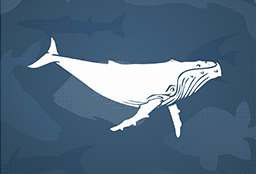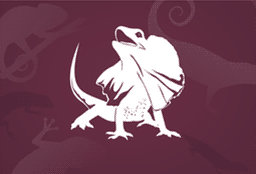Black and white, with the pattern varying across its range. The back of its neck, upper tail and shoulders (on its wings) are white in males and grey in females, and (across most of Australia) the rest of its body is black. In south-eastern, central and south-western Australia, including Tasmania, its back and rump are entirely white. Its eye is red-brown. Young birds are usually grey rather than black and have dark eyes.
Distinctive feature
One toe faces backwards and three face forwards. It has a square-tipped tail.
A medium shorebird with long skinny legs and a long beak. The Oystercatcher has a black head and black with a white belly, orange-red eyes, and very distinctive orange legs and beak.
Size
50 cm long (from head to tail)
A type of marine snail (mollusc) with a distinctive round or globe-shaped shell, black or dark grey in colour. The older snails will sometime have a white patch at the flattened tip (apex) of the spirals (whorls) due to weathering.
Nerites have a white aperture (where the snail comes out) with a black rim and they usually have a black operculum (shell door or lid) which is sometimes spotted orange.
Adults have a black body and neck with white wing tips, black legs and a red bill with white bar near tip. Male carries head higher than female in mated pair and has darker bill and iris. Juveniles are lighter in colour and cygnets have grey-brown plumage.
Size
body length 110 - 140 cm; wingspan 160 - 200 cm
Its pear-shaped float (bottle) is a translucent blue, with a wrinkled top which might be tinged with green or pink. It has a single main tentacle, and many shorter tentacles, all of which are blue and hang from its float.
It is not a single animal but rather a colony of four kinds of individuals known as polyps. Each polyp has its own function: one is the float, another captures food, another digests the food, and another is responsible for reproduction.
Size
Float is 2 – 15 cm long, and tentacles up to 10 m.
It has a blue float made of a flat, circular disc with many gas-filled tubes which keep it afloat. The disc is surrounded by tiny blue tentacles.
The Blue Button is, in fact, a colony made up of different types of polyps, including some that are specialised for catching food, defense, or reproduction.
Size
Its disc is up to 2.5 cm across.
Small marine snails (molluscs), often called Australwinks.
They are light blue to grey in colour and have a smooth shell that spirals up to a light brown to reddish-brown sharp tip (apex).
Size
10 - 15 mm
A very large brown seaweed (algae). It has dark brown leathery, strap-like branches (thallus).
It attaches to the substrate by a large disc or conical-shaped holdfast. Usually there is a single leathery frond (stalk) from the holdfast, which divides into long segments or fronds.
Its strong holdfast often pulls off pieces of granite during storms which can remain attached to the kelp when washed up on shore.
The caterpillar (larva) is initially pale yellow with fine hairs, before turning green. It has narrow yellow lines on its body which are sometimes hard to see. The upper side of the butterfly (adult) is white with a black tip on its forewing (front wing) and a black patch on the front edge of its hindwing. A male has one black spot on its forewing, while a female has two black spots. Looking from underneath, the forewing is white with two black spots and the hindwing is yellow.
Size
Caterpillar about 3.5 cm; Butterfly up to 5 cm wingspan.
Shrub or small pyramidal tree, yellowish green or bronzy. Commonly 8 - 10 m high.
Numerous branchlets are hairy and flaky at first then become smooth and straight.The swollen orange to red stalk preceding the small hard fruit is often mistaken as the fruit itself.
Leaves
Scale-like, triangular, 0.5 mm long and 2 – 3 mm long on new growth.
Flowers
Yellow-green flowers in short, dense, clusters that are usually 6 mm long. Flowers appear in early spring to autumn (September to May).
Its genus name Leptospermum is from Greek leptos (thin) and sperma (seed), referring to its small seeds; and its species name laevigatum is from Latin laevigatus (smooth), probably referring to the appearance of the plant.
Also known as Australian Myrtle and Victorian Tea Tree.
A tall, bushy shrub or small tree, with bark that sheds in strips. Grows up to 6 m tall.
Leaves
Grey-green and obovate (egg-shaped and flat, with the narrow end attached to the stalk). They are 1.5 – 3 cm long and 5 – 8 mm wide.
Flowers
White and usually in groups of two. The flower heads are usually 1.5 – 2 cm in diameter, and made up of five petals that are 5 – 8 mm long, with many stamens protruding from the centre that are 2 mm long.
The adult male is black with a deep-orange to yellow beak, a narrow orange to yellow ring around its eye, and dark legs. The female is grey-brown, with some streaks or mottling, and its back is darker than its belly. The female also has a paler chin than the male, a dull yellow-brown beak, dark legs, and the ring around her eye is less bright. Young birds are also brown but with lighter underparts and a dark grey or black beak.
Size
25 to 28 cm (from head to tail)
The caterpillar (larva) is initially a pale yellow-grey, before turning green with long black hairs along its body. Its head is brown-black with short hairs. The female butterfly (adult) is orange with creamy yellow and dark brown patches towards the tip of its forewings (front wings). The male is less colourful, being brown and orange with no pale patches. It also has an obvious raised vein in the middle of its forewing. Both males and females have a small eye-spot on each wing. The undersides of the wings in both the male and female are paler with faint markings, and their hindwings have very few markings. The female’s hindwing is darker then its forewing. It is difficult to identify these butterflies when they are resting with their wings closed. The males emerge quite a while earlier in the year before the females.
Size
Caterpillar about 3.5 cm long; Butterfly wingspan 5.5 – 7.5 cm (females are larger than males).
A type of sea squirt, an animal that forms large colonies as a dense mat over rocks which are highly visible at low tide.
Its shape is squat and globular. It has a thick leathery outer layer called a ‘tunic’ which is often covered with brown or green algae. Cylindrical in shape with 2 openings called siphons for inhaling and exhaling water and feeding.
This frog goes by several common names: Eastern Banjo Frog, Eastern Pobblebonk Frog and Southern Bullfrog. The first two are based on its distinctive 'bonk' call which sounds similar to the string of a banjo being plucked.
Its back ranges from grey, to olive-green, dark brown or black, with dark marbling or flecks. It has a pale yellow stripe running from under its eye to its arm, a dark band above this, and may also have a pale stripe running down its back. Its sides commonly have a purple or bronze sheen, mottled with black. Its belly is white and sometimes mottled with grey. Its back is warty and rough but its belly is smooth.
Distinctive feature
A prominent gland on the outer side of its hind leg (its shin) and a fleshy lump at the base of each hind foot.
It has a grey back and head, and bright-yellow underparts. Southern birds have an olive-yellow rump, while birds in northern Australia have a brighter yellow rump. Its throat is off-white and when seen in flight, it has a pale bar on its wings. Its bill is black. Young birds are rufous-brown with paler streaks.
Size
13 – 17 cm long, the males are slightly larger
Elephant snails are a type of semi-rare solitary marine snail (mollusc) and look like a black slug with a small white, shield-like shell on their backs.
Size
70 - 150 mm
Bright yellow and black bands across its abdomen, with a pair of black spots and a black triangle on each yellow band. It has yellow legs, black antennae and two pairs of transparent wings. Nests are commonly built underground with only their small entrance holes visible, which are about 2 - 3 cm across.
Size
1.2 – 1.5 cm long (worker); 2 cm long (queen)
An adult male has a bright orange breast and throat, with white on its lower belly and under its tail. The upperparts are dark slate grey and there is a clear white stripe on its folded wing. It has a black beak and dark brown legs. A female is mostly grey-brown with a pale buff strip on its wing. Its outermost tail feather is mostly white. A young bird looks like an adult female, but its back has buff streaks and its belly is pale with brown streaks.
Size
12 - 14 cm
Grey-brown to bronze, with a dark stripe running along each side of its body from its nostril, across its eye to its tail, getting wider from its front legs. Its body pales below the stripe to a cream belly.
This species has a lighter body with a less obvious stripe running along its sides than the Southern Garden Skink.
Size
8 - 10 cm (nose to end of tail).
Grey-brown to bronze, with a dark stripe running along each side of its body from its nostril, across its eye to its tail, getting wider from its front legs. Its body pales below the stripe to a cream belly.
This species has a ‘heavier’ looking body and a more obvious stripe running along its sides, compared to the Northern Garden Skink.
Size
8 - 10 cm (nose to end of tail).
Barnacles are small invertebrates that live inside hard circular or pyramid-like structures made from calcium-carbonate. They are distinguished by their size: they are taller than they are round and have similar shape to a volcano. They can be found singularly or in a group.
Giant rock barnacles are the largest type of barnacle and are comprised of six large plates that are white to light green in colour, and have top to bottom (transverse) grooves on them. They have a distinctive bright blue body (mantle) inside.
Barnacle larva are free swimming and live in the plankton layer and when they are old enough they return to the rocky shores where they find a spot and cement their heads to the rock and then grow their shell around their body.
Size
30 - 60 mm height and 25 - 30 mm diameter.
The adult male has a bright-yellow underbody, olive-green back and wings, and a black head with a bright-yellow collar. Its throat is white, with a broad black band which separates it from the yellow breast. Its beak and legs are black. The adult female has grey upperparts with a pale olive tinge, and is pale grey below with a pale yellowish tinge. Its beak is dark brown and its legs are grey-brown. Both sexes have a red-brown eye. Juvenile birds are rufous above and below, and as they mature, gradually resemble a female, though they retain some rufous feathers in their wings.
Medium sized shorebird with a straight, slender bill and a heavily streaked head and neck. Non breeding plumage in Australia; pale to chestnut head, neck and upper breast. White underparts.
In breeding plumage they have a black band across the chest, and black, white and reddish speckles on the upperparts (Great Knots breed in Siberia).
Size
A medium-sized shorebird






